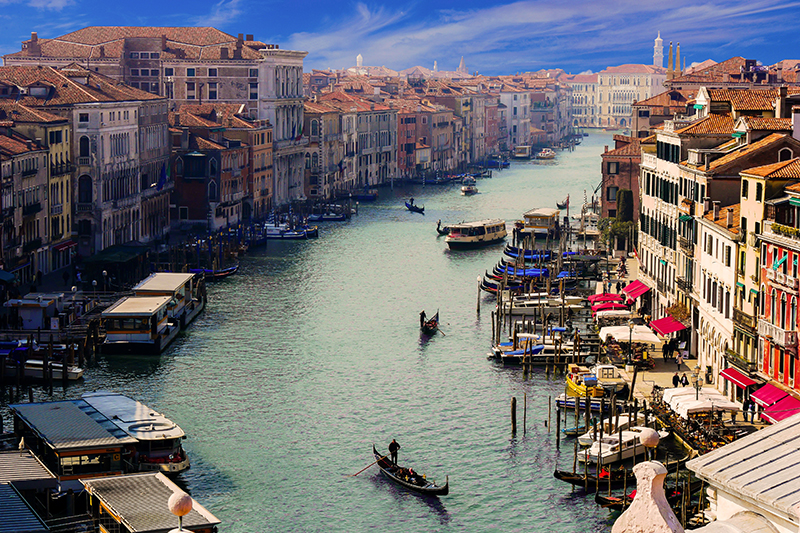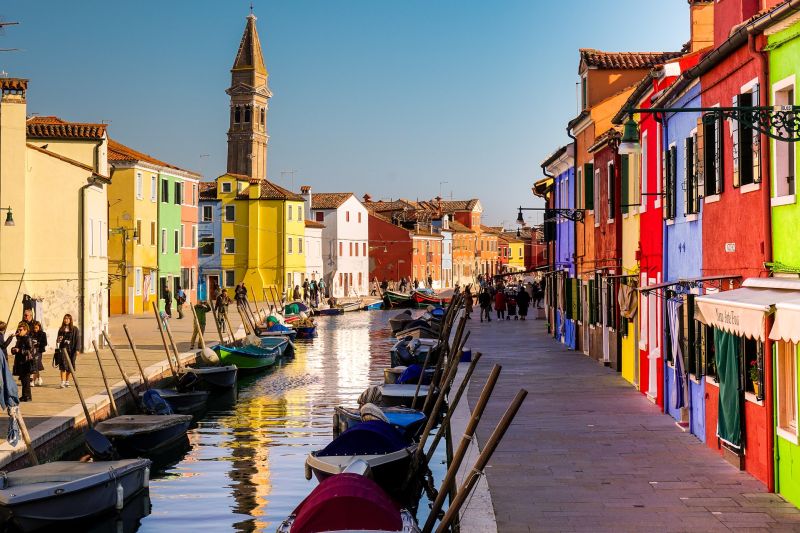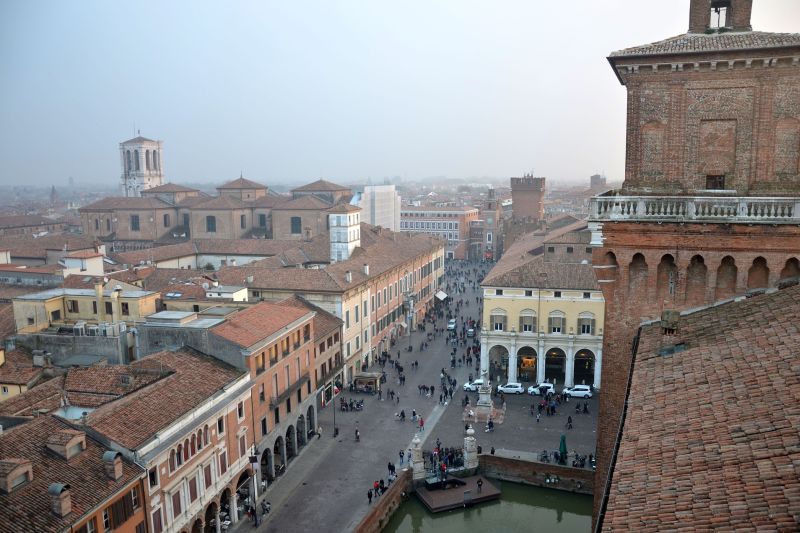Italy is a wonderful destination for a canal cruising holiday. The very popular tourist destination has a network of picturesque rivers and canals to explore, and some of the best are found around the iconic Veneto region. One of the most popular options for a river cruise in Italy is to travel from Venice to Mantua, which will take you through stunning scenery and a number of interesting towns along the way. Here are some of the highlights of the top six places to visit, aboard La Bella Vita…

1. Venice
Venice is one of the top places to visit aboard La Bella Vita. If you embark from here, make sure you spend some time exploring this unique city. The canals and attractions of Venice are truly spectacular and there really is nowhere else quite like it.
Explore the Grand Canal from a traditional gondola, eat in the excellent restaurants, and take in the myriad famous sights, which include the Chiesa del Redentore, the Basilica di Santa Maria della Salute, the Punta della Dogana and St Mark’s Square. Many of these are visible from the canals. Venice is also the perfect city for getting lost. As you wander through the ancient streets you’ll come across a host of off the beaten track attractions that you may otherwise have missed.

Chiesa del Redentore
Il Redentore, as it’s commonly known, is one of Venice’s two renowned plague churches. It was built in the sixteenth century in dedication to Christ the Redeemer during the terrifying bout of plague that spread throughout the city. You’ll find it on the island of Giudecca, which boasts beautiful views over the water of St. Mark’s and the Zattere.
Basilica di Santa Maria della Salute
It’s hard to miss this magnificent basilica, which sits prominently at the entrance of the Grand Canal. Its white stones and spectacular domes attract the eye and under the Italian sun the entire building seems to glow. Built in1630 as an appeal to the Madonna after 80,000 Venetians died from the plague, the church certainly has a divine feel about it – particularly if you enter the light filled interiors.
Punta della Dogana
This iconic building is recognisable on any cruise that begins in Venice. The Sea Customs House, as it stands today, was completed in 1682 and was a functioning customs house until the 1980s. Today, it’s used as a contemporary art space, reopening in 2009 to the delight of the public. If you look closely at the characteristic tower at the entrance, you’ll see a sculpture of two Atlases holding a bronze sphere. The giant ball turns to indicate the direction of the wind.
Doge’s Palace
A symbol of Venice, the Palazzo Ducale was originally built as a fortified castle around the tenth century. After a devastating fire in the late eleventh century, the palace was rebuilt as a fortress and prison, but it’s had many lives over the years. It was also once the Doges’ residence and public offices and over a period of 1000 years, 120 doges have ruled Venice from this impressive structure. It’s a marvellous display of architectural styles, including Byzantine, Gothic and Renaissance.
As well as having all of these fantastic sights to see, the Grand Canal in Venice is an attraction in itself. It was even used as a filming location for James Bond’s Casino Royale. Experience Venice and its surroundings on a luxury barge cruise and it’s something you’ll never forget.
2. Choggia
Chioggia, another favourite in our top six places to visit aboard La Bella Vita on a river cruise in Italy, is a true hidden gem that’s often referred to as ‘Venice without the tourists’. Stunning Chioggia is also famous for its fish market, which is one of the most important in Italy. It’s well worth taking the time to explore if your itinerary allows it. It is a very picturesque town with sights including the impressive cathedral and Piazzetta Vigo.

The Bragozzo: Traditional Fishing Boats
Experience the history of this charming town with a ride on a traditional fishing boat. The bragozzo were the most common boats between the eighteenth and early twentieth centuries. Although today’s boats are equipped with engines, traditionally they would have had two sails. But their signature coloured hulls still remain, so be sure to get a few photos of them in action!
San Domenico
Make your way to the end of Calle Santa Croce over the bridge and you’ll come across an ancient cloister founded in 1287: Saint Domenico’s Church. This Romanesque church is steeped in history and tradition, but it’s the “Fisherman’s Christ” that attracts many visitors. To this day no one really knows where it came from.
Duomo
Chioggia’s cathedral is an impressive building and was built by the same architect as the Salute church in Venice. Inside you’ll find an extravagant seventeenth century altar and a beautiful side chapel. The chapel on the left is dedicated to the town’s patron saints, Felix and Fortunatus. There’s also a beautiful stained glass window, although this is a little newer, dating back to the end of the nineteenth century.
Historic Fish Market
In a fishing town the fish market is a must-see, and as one of the oldest institutions in the town, it’s a fun experience – especially if you dedicate yourself to getting up at 4 a.m. to watch the fishing boats bring their fresh catch into the market. If you’d rather lie in, you can always visit the market later in the day, which offers a vast array of seafood and fish.
3. Adria
Adria has a long history that dates back to the sixth century B.C., when it was situated on the river Po. If you’re interested in experiencing some history on your river cruise in Italy, add this to your itinerary. The city was once an important port, which meant it had many rulers over the years. Although it became more distant from the sea as the Po delta became filled in, today it’s connected to the coast thanks to the Canal Bianco.

Etruscans & The Archaeological Museum
Thanks to its long and turbulent history, Adria has a fantastic archaeological museum, which is well worth a visit on your river cruise in Italy. The museum houses a remarkable display of private collections, including that of the Bocchi family from 1770. You’ll be able to marvel at artefacts dating back to the booming years of the city in the sixth century B.C. Here you’ll see evidence of the variety of civilizations that lived in the city: Paelo-Venetians, Greeks and Etruscans. There are also remnants of the Roman presence shown in the ceramics on show.
4. Taglio di Po
This is another town along the route from Venice to Mantua that is a great addition to any river cruise in Italy. One of the main highlights is the Villa Ca’Zen, a seventeenth century villa where Lord Byron wrote some of his best poetry. Here, guests will have the opportunity to wine and dine with the countess of Villa Ca’Zen herself. In addition, you can visit Villa Widmann Borletti, where you can enjoy some wine tasting.
Villa Ca’Zen
Dating back to the eighteenth century, the Tenuta Ca’Zen is set in a tranquil green landscape of the Po Delta. The estate is extensive, with a chapel, stables, a warehouse and two farmhouses, as well as the manor itself. As you explore the villa you’ll get a sense of the wealth and beauty of the place. It offers a welcome moment of calm after a few days exploring towns and cities.

5. Ferrara
This delightful Renaissance city has many attractions and is a worthwhile place to alight from the vessel for a few hours if you get the chance during your river cruise in Italy. You can see Estense Castle with its moat and drawbridges and visit Schifanoia Palace to see its impressive frescoes dating back to the fifteenth century.

Schifanoia Palace
This palazzo is a wonderful display of Renaissance splendour, and is a well known symbol of Este Ferrara. Built around 1385-1391, it was used as a suburban retreat to “escape boredom” (“schifar la noia” in Italian), hence its name. It was the jewel of court life in the fifteenth and sixteenth centuries. Today, it’s been transformed into a museum that offers an immersive experience of the extravagance of the past. Don’t miss the Hall of Months, which is one of the most important fifteenth century frescoes in Italy.
Castello Estense
Following a violent revolt in 1385, Niccolo II d’Este resolved to build this impenetrable castle for himself and his family. Complete with thick walls, a moat, drawbridges and many towers offering excellent vantage points from which to spot enemies, the Castello Estense is an imposing building. But over the years it became a Renaissance style residence of the court, embellished with marble balconies and extravagant apartments. You can explore all of this if you choose to visit on your river cruise in Italy.
Ferrara’s Cathedral
Beautiful both inside and out, this cathedral was built in the twelfth century and its marble facade is a wonderful example of the Romanesque style. Step inside and you’ll enter a world of Baroque ornate decoration covering the interiors. Spend some time in the cool and the quiet to explore all the alcoves of this beautiful building.
6. Mantua
The final destination on your river cruise in Italy is Mantua, which was home to artists Donatello and Mantegna, as well as the poet Virgil – making it another of our top six places to visit aboard La Bella Vita. It is in a stunning lakeside setting, with buildings displaying both Baroque and Neoclassical architecture. You can visit the Ducal Palace and explore its many courtyards and gardens, as well as enjoy the many paintings and sculptures inside.

Mantegna in Mantua
Mantegna was known as an artist who loved his independence, however, it was thanks to the patronage of Marchese di Mantova (Mantua), Ludovico Gonzaga, in 1459, that he created some of his best-known surviving work. That is, the Camera degli Sposi in the Palazzo Ducale in Mantua. In this famous artwork Mantegna created an illusion of depth with his three-dimensional perspective. The realistic quality of the work made it a highly influential example of this kind of art in the early Renaissance, and the legacy of Mantegna in Mantua lives on today.
The Ducal Palace of Mantua
This is the home of Mantegna’s famous frescoes: the Ducal Palace. Used as the official residence of the Gonzaga family from the fourteenth to the eighteenth century, the palazzo has a rich and interesting history. As you’ll see from its imposing architecture, it has also been used as a fortress and was used as a defensive structure for the centre of the town. Although it seems to be one building, historically it consisted of several structures that were merged together in 1556. You’ll be able to explore the different structures during your visit, including the famous Camera degli Sposi by Andrea Mantegna.
Discover Italy’s Waterways
A luxury river cruise in Italy is the perfect way to discover this wonderfully historical and culturally blessed country. The route between Venice to Mantua is incredibly beautiful, and travelling by water is the perfect way to experience the very best of the landscape, with a host of interesting places to stop off.
Travel from Venice to Mantua (or vice versa!) and experience our top six places to visit aboard La Bella Vita. Highlights on this river cruise in Italy include visits to all the beautiful towns mentioned above, plus gourmet meals served by an onboard chef, daily private excursions, spacious en-suite cabins and so much more! Speak to a member of our Cruise Teams via our Contact Form for more information, or order your free copy of our brochure.
